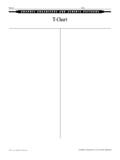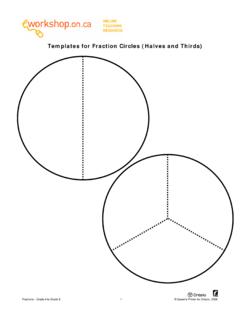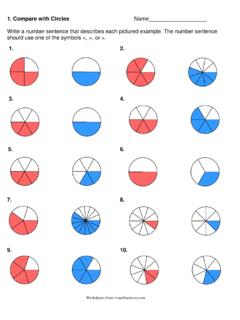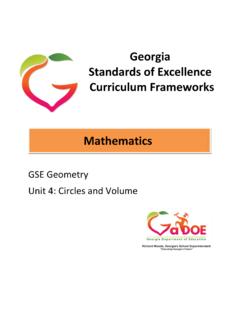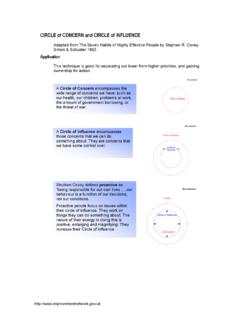Transcription of Compiled By: Pat Elliott, Resource Teacher & Dale Mays ...
1 Compiled By: Pat Elliott, Resource Teacher & Dale Mays, Grade 4 Teacher Simcoe County District School Board Ontario Canada Literacy Circles There is no one right way to conduct literacy circles. The manner in which you use this strategy for reading responses is as individual as you are. The approach may change from class to class, Teacher to Teacher , student to student and sometimes-even day to day. The students take ownership. The students take responsibility as readers, group members and organizers.
2 You will notice some very positive behaviours: animated discussion, serious participation, favourite passages being read aloud, text being re-read to prove points or settle arguments, What Are Literacy Circles? Small groups of students meet to thoroughly discuss reading passages (can be poems, short stories, novels, fiction or non-fiction). The discussion is child directed and child centred. The discussion is guided by the students response to what they have read. The circles allow students to engage in critical thinking and reflection through reading, discussing and responding to literature.
3 Students are enthusiastic, motivated and actively involved. Literacy circles are part of a balanced literacy program. Balanced Reading Program From Chapter 1, Getting Started with Literature Circles by Katherine L. Schlick Noe & Nancy J. Johnson. 1999 Christopher-Gordon Publishers, Inc. Opportunities for applying skills , literacy circles, research, content area reading/writing Independent Reading/Writing Shared Reading/Writing Guided Reading/Writing Reading Aloud This table outlines the implementation of Literacy Circles over time.
4 The approach you take will change as you and the students become more comfortable with the format. Beginners More Experienced Skilled Timeline - 3-6 weeks - focus on learning the process - 3-6 weeks - focus on developing responses - 3-6 weeks focus on increasing complexity of responses Schedule - Teacher sets schedule of when to meet, length of cycle, when to prepare etc. - groups usually meet 1/week, read and prepare responses when not meeting - Teacher and students discuss length of cycle - groups meet and discuss when to meet, prepare etc.
5 - groups usually meet 1/week, but may alter to fit their own needs - groups meet, discuss, and decide on their own when to meet, prepare etc. Choosing Books - whole class reads the same book/passage etc. if sufficient copies are available - Teacher chooses - anthologies - that s what we have - 2 or 3 choices of titles - books need to be relevant and interesting - 4 or 5 choices of titles - could be theme/subject related - author studies - genre studies Forming Groups - Teacher forms groups - usually homogeneous ability - Teacher gives book talks - students give preferences/ Teacher forms groups based on ability and interest - Teacher and/or students give book talks - students choose group - groups may
6 Be mixed ability Discussion - Teacher facilitates discussion or participates as a member - students use role sheets to guide them - Teacher can facilitate group or act as a member or observer - students generate discussion following guidelines of the role sheets - groups run themselves - Teacher roams and observes - group can modify role sheet to fit particular book or not use them at all Written Responses - respond to each chapter of the book using response journals or questions - use role sheets to prepare for circle - set number of responses expected per week ( either journal responses or questions) - may modify role sheets - variety of response forms are acceptable (written, art, etc.)
7 - may modify role sheets or not use them at all Assessment - What Assessment? - or anecdotal notes re: circles - some student self/peer assessment - choose 1 or 2 responses to be graded at the end of the book - extensive student self/peer assessment - greater focus is put on discussion Adapted from Literature Circles and Response (2001) by Bonnie Campbell Hill, Katherine L. Schlick Noe, and Nancy J. Johnson. Christopher-Gordon Publishers, Inc. There are 4 roles, which are consistently used: See the attached role sheets for more details about the responsibilities for each role.
8 Students roles rotate each time the group meets. Discussion Director Summarizer Illustrator Literary Luminary When doing historical fiction, the roles of Fact Finder or Time Liner are most appropriate. For more information, check one of these resources. Daniels, Harvey. Literature Circles Voice and Choice in the Student Centred Classroom. Markham: Pembroke Publishers, 1994. Hill, Bonnie Campbell, Katherine L. Schlick Noe and Nancy J. Johnson. Literature Circles and Response. Norwood, MA: Christopher-Gordon Publishers, 1995.
9 Hill, Bonnie Campbell, Katherine L. Schlick Noe and Nancy J. Johnson. Literature Circles Resource Guide: Teaching Suggestions, Forms, Sample Book Lists, and Database of books for Literature Circles. Norwood, MA: Christopher-Gordon Publishers, 2001. Moen, Christine Boardman. 25 Reproducible Literature circle Role Sheets for Fiction and Nonfiction Books. Carthage IL: Teaching & Learning Company, 1998. Noe, Katherine L. Schlick and Nancy J. Johnson. Getting Started With Literature Circles. Norwood, MA: Christopher-Gordon Publishers, 1999.
10 Web Sites: Compilation of links to resources on the Internet. (based on Harvey Daniels book) Literature circle Schedule Record the names of the members of your group. 1. _____ 2. _____ 3. _____ 4. _____ 5. _____ 6. _____ Title of the book you are reading? _____ Our group will meet on these dates and have read the pages (chapters) Date: _____ Pages: _____ Date: _____ Pages: _____ Date: _____ Pages: _____ Date: _____ Pages: _____ Date: _____ Pages: _____ Date: _____ Pages: _____ Date: _____ Pages: _____ Date: _____ Pages: _____ Date: _____ Pages: _____ Date: _____ Pages: _____ Date: _____ Pages: _____ Book Title: _____ Our roles will change as follows: Date: _____ Date.
